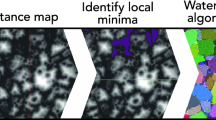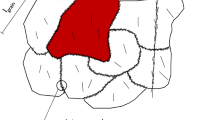Abstract
We invoke pore-scale models to evaluate grain shape effects on petrophysical properties of three-dimensional (3D) images from micro-CT scans and consolidated grain packs. Four sets of grain-packs are constructed on the basis of a new sedimentary algorithm with the following shapes: exact angular grain shapes identified from micro-CT scans, ellipsoids fitted to angular grains, and spheres with volume and surface-to-volume ratio equal to original angular grains on a grain-by-grain basis. Subsequently, a geometry-based cementation algorithm implements pore space alteration due to diagenesis. Eight micro-CT scans and 144 grain-pack images with \(500 \times 500 \times 500\) voxels (the resolution units of 3D images) are analyzed in this study. Absolute permeability, formation factor, and capillary pressure are calculated for each 3D image using numerical methods and compared to available core measurements. Angular grain packs give rise to the best agreement with experimental measurements. Cement volume and its spatial distribution in the pore space significantly affect all calculated petrophysical properties. Available empirical permeability correlations for non-spherical grains underestimate permeability between 30 and 70 % for the analyzed samples. Kozeny–Carman’s predictions agree with modeled permeability for spherical grain packs but overestimate permeability for micro-CT images and non-spherical grain packs when volume-based radii are used to calculate the average grain size in a pack. We identify surface-to-volume ratio and grain shape as fundamental physical parameters that control fluid distribution and flow in porous media for equivalent porosity samples.


















Similar content being viewed by others
Notes
When grain size is small relative to the size of pores among already deposited larger grains, we start the random search of the initial position within a stationary bed to allow smaller grains to become positioned in internal pores. Physically, this process replicates grain packs which could be obtained by shaking and vibrating the grain bed during the packing process. The porosity of the grain pack constructed in this manner is lower than that of grain packs for which the grains are always stacked vertically from the top independently of their size.
Abbreviations
- \(k\) :
-
Absolute permeability (D) \((\hbox {1 D }=1\hbox { Darcy} = 9.869233 \times 10^{-13}\hbox { m}^{2})\)
- \(S_\mathrm{vapor}\) :
-
Mercury vapor (wetting phase) saturation in mercury–air system (fraction)
- \(P_\mathrm{c}\) :
-
Capillary pressure (Pa)
- \(\theta \) :
-
Contact angle (degrees)
- \(F\) :
-
Formation factor (dimensionless)
- \(\gamma \) :
-
Interfacial tension (\(\hbox {mN}\,\hbox {m}^{-1}\))
- \(C\) :
-
Local mean curvature of the interface (\(\hbox {m}^{-1}\))
- \(D\) :
-
Median grain diameter (m)
- \(a\) :
-
Permeability model parameter (dimensionless)
- \(b\) :
-
Permeability model parameter (dimensionless)
- \(r_\mathrm{c}\) :
-
Pore radius (m)
- \(m\) :
-
Porosity exponent (dimensionless)
- \(\phi \) :
-
Porosity (fraction)
- \(S\) :
-
Grain’s surface area (\(\hbox {m}^{2}\))
- \(S_\mathrm{w}\) :
-
Water (wetting phase) saturation in brine–oil system (fraction)
- \(V\) :
-
Grain’s volume (\(\hbox {m}^{3}\))
- 2D:
-
Two-dimensional space
- 3D:
-
Three-dimensional space
- CT:
-
X-ray computed tomography
- MICP:
-
Mercury injection capillary pressure
- REV:
-
Representative elementary volume (\(\hbox {voxel}^{3}\))
- SCAL:
-
Special core analysis program
- \(i\) :
-
\(i\mathrm{th}\) grain
- \((s/v)\) :
-
Based on surface-to-volume ratio
- \((v)\) :
-
Based on volume
References
Archie, G.E.: The electrical resistivity log as an aid to determining some reservoir characteristics. Trans. Am. Inst. Min. Metall. Petrol. Eng. 146, 54–62 (1942)
Bachmat, Y., Bear, J.: Macroscopic modelling of transport phenomena in porous media. 1: the continuum approach. Transp. Porous Med. 1, 213–240 (1986)
Berg, R.R.: Capillary pressures in stratigraphic traps. Am. Assoc. Petrol. Geol. Bull. 59, 939–956 (1975)
Bolte, S., Cordelières, F.P.: A guided tour into subcellular colocalization analysis in light microscopy. J. Microsc. 224, 213–232 (2006)
Carman, P.C.: Flow of Gases Through Porous Media. Academic Press Inc., New York (1956)
Coelho, D., Thovert, J.F., Adler, P.M.: Geometrical and transport properties of random packings of spheres and aspherical particles. Phys. Rev. 55, 1959–1978 (1997)
García, X., Akanji, L., Blunt, M., Matthai, S., Latham, J.-P.: Numerical study of the effects of particle shape and polydispersity on permeability. Phys. Rev. 80, 021304 (2009)
Hilpert, M., Miller, C.T.: Pore-morphology based simulation of drainage in totally wetting porous media. Adv. Water Resour. 24, 243–255 (2001)
Jin, G., Torres-Verdín, C., Lan, C.: Pore-level study of grain-shape effects on petrophysical properties of porous media: Transactions of the Society of Petrophysicists and Well Log Analysts, 50th Annual Logging Symposium, Woodlands, TX, USA, 21–24 June 2009
Lehmann, P., Berchtold, M., Ahrenholz, B., Tölke, J., Kaestner, A., Krafczyk, M., Flühler, H., Künsch, H.R.: Impact of geometrical properties on permeability and fluid phase distribution in porous media. Adv. Water Resour. 31, 1188–1204 (2008)
Øren, P.E., Bakke, S.: Process based reconstruction of sandstones and prediction of transport properties. Transp. Porous Med. 46, 311–343 (2002)
Prodanović, M., Bryant, S.L., Davis, J.S.: Numerical simulation of diagenetic alteration and its effect on residual gas in tight gas sandstones. Transp. Porous Med. 96, 39–62 (2012)
Rasband, W.S.: ImageJ, U.S. National Institutes of Health, Bethesda, MD, USA, http://imagej.nih.gov/ij/ (1997–2013)
Revil, A., Cathles, L.M.: Permeability of shaly sands. Water Resour. Res. 35, 651–662 (1999)
Rumpf, H., Gupte, A.R.: The influence of porosity and grain size distribution on the permeability equation of porous flow. Chem. Ing. Tech. 43, 367–375 (1975)
Saadatfar, M., Sheppard, A., Knackstedt, M.: Advances in X-ray Tomography for Geomaterials. ISTE Publishing Knowledge, London (2006)
Schembre-McCabe, J., Salazar-Tio, R., Ball, G., Kamath, J.: A framework to validate digital rock technology: International Symposium of the Society of Core Analysts, SCA2011-28, Austin, TX, USA, 18–21 September 2011
Schwartz, L.M., Kimminau, S.: Analysis of electrical conduction in the grain consolidation model. Geophysics 52, 1402–1411 (1987)
Sen, P.N., Scala, C., Cohen, M.H.: A self-similar model for sedimentary rocks with application to the dielectric constant of fused glass beads. Geophysics 46, 781–795 (1981)
Shabro, V., Torres-Verdín, C., Javadpour, F.: Pore-scale modeling of apparent permeability and resistivity of hydrocarbon-bearing shale in the presence of desorption, Transactions of the Society of Petrophysicists and Well Log Analysts, 52nd Annual Logging Symposium, Colorado Springs, CO, USA, 15–18 May 2011
Shabro, V., Javadpour, F., Torres-Verdín, C., Sepehrnoori, K.: Finite-difference approximation for fluid-flow simulation and calculation of permeability in porous media. Transp. Porous Med. 94, 775–793 (2012)
She, F.H., Chen, R.H., Gao, W.M., Hodgson, P.D., Kong, L.X., Hong, H.Y.: Improved 3D Thinning algorithms for skeleton extraction: Institute of Electrical and Electronics Engineers, Digital Image Computing: Techniques and Applications, DICTA’09, December (2009)
Silin, D., Patzek, T.: Pore space morphology analysis using maximal inscribed spheres. Phys. A Stat. Mech. Appl. 371, 336–360 (2006)
Torskaya, T., Torres-Verdín, C.: Process-based sedimentation modeling using arbitrary-shaped grains: Joint Industry Research Consortium on Formation Evaluation, Proceedings of the 10th Annual Meeting. Austin, TX, USA, 18–20 August 2010
Torskaya, T., Jin, G., Torres-Verdín, C.: Pore-level analysis of the relationship between porosity, irreducible water saturation, and permeability of clastic rocks: Society of Petroleum Engineers Annual Technical Conference and Exhibition Proceedings, SPE 109878, Anaheim, CA, USA, 11–14 November 2007
Wadell, H.: Volume, shape and roundness of quartz particles. J. Geol. 43, 250–280 (1935)
Acknowledgments
A note of special gratitude goes to Maša Prodanović and Pawel Matuszyk for useful technical discussions, as well as to an anonymous reviewer whose constructive technical and editorial comments improved the first version of the manuscript. We thank Mark Knackstedt’s research group at the Australian National University for the segmentation of CT scan images, and Chevron, Statoil, and Total E&P USA for permission to publish measurements and calculations associated with micro-CT images. The work reported in this paper was funded by The University of Texas at Austin’s Research Consortium on Formation Evaluation, jointly sponsored by Anadarko, Apache, Aramco, Baker-Hughes, BG, BHP Billiton, BP, Chevron, China Oilfield Services, LTD., ConocoPhillips, ENI, ExxonMobil, Halliburton, Hess, Maersk, Marathon Oil Corporation, Mexican Institute for Petroleum, Nexen, ONGC, Petrobras, Repsol, RWE, Schlumberger, Shell, Statoil, Total, Weatherford and Woodside Petroleum Limited.
Author information
Authors and Affiliations
Corresponding author
Rights and permissions
About this article
Cite this article
Torskaya, T., Shabro, V., Torres-Verdín, C. et al. Grain Shape Effects on Permeability, Formation Factor, and Capillary Pressure from Pore-Scale Modeling. Transp Porous Med 102, 71–90 (2014). https://doi.org/10.1007/s11242-013-0262-7
Received:
Accepted:
Published:
Issue Date:
DOI: https://doi.org/10.1007/s11242-013-0262-7




